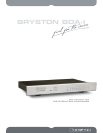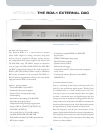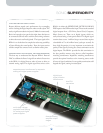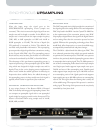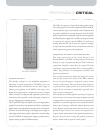
SYncHronouS upSAMpLiNG PErForMAncE CRiTiCAL
5
POWER SUPPLY
The stability of power in any audiophile equipment is
imperative to superb performance. The BDA-1 uses two
independent power transformers for the initial stages of
filtering and regulation. In the BDA-1, each stage in the
digital chain (input receiver > sample rate converter > digital
audio converter) is independently regulated to prevent any
interactions and to provide a rock solid supply of power for
any up-sampling/over-sampling process.
The Crystal DAC chip also requires a very clean digital power
supply if it is to function at its optimum level. Noise on the digital
supply could cause added jitter and various forms of distortion.
Incorrect circuit board routing of the digital power supply or
related ground may also introduce digital noise into the analog
circuits. The BDA-1’s digital power supply is provided from a
separate closely regulated and filtered source.
The DAC also requires a high quality analog power source.
The analog signal is at its lowest magnitude within the DAC
and as it exits the chip, so any induced noise or distortion will
be greatly amplified by circuitry upstream from the DAC.
Bryston engineers have employed a separate, heavily regulated
and filtered power supply with carefully routed grounds that
is critical to the superior sound of BDA-1. Careful trace
routing eliminates the risk of noise via capacitive coupling
and provides the extra dB’s of noise and distortion reduction
which separate truly great audio equipment.
DISCRETE CLASS-A ANALOG STAGE
The most critical part of the circuit design in the
Bryston BDA-1 is the DAC’s analog outputs—connected
directly to a pair of proprietary Bryston Class A discrete
operational amplifiers rather than the typical IC chips
employed in most other products. These exotic amplifiers
make a huge difference in transparency, resolution and
dynamic performance.
The use of discrete devices allows the design of a circuit
that exactly matches the needs of the DAC, whereas
the use of general-purpose integrated circuits always
involves compromises. Discrete devices allow engineers
to generate more output power since the heat from the
output driver transistors is physically separated from
other sensitive components.
Discrete devices also allow specific matching of important
characteristics such as input and output impedances based
on the specific in-circuit requirements. Discrete operational
amplifiers can also be designed to more closely match their
power source leading to additional reduced distortion and
noise. Bryston consistently utilizes discrete devices in our
product designs because our circuits are engineered to
require closely matched devices for optimum performance.
Bryston does ultra-fine sorting and grading of discrete
devices, which leads to superior sound quality.
OPTIONAL REMOTE



